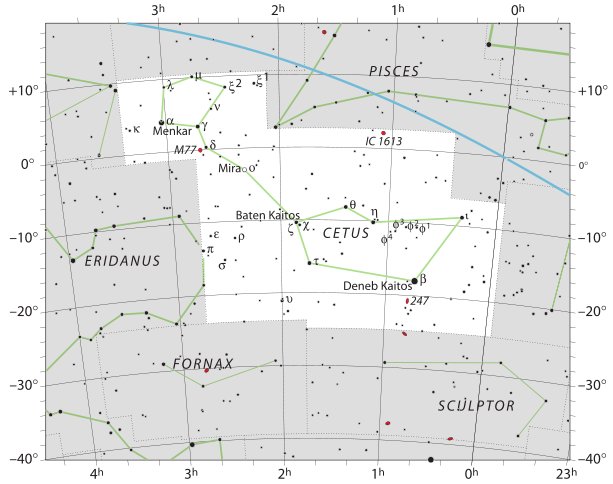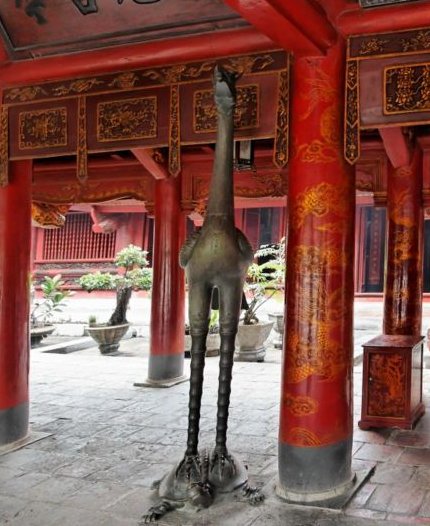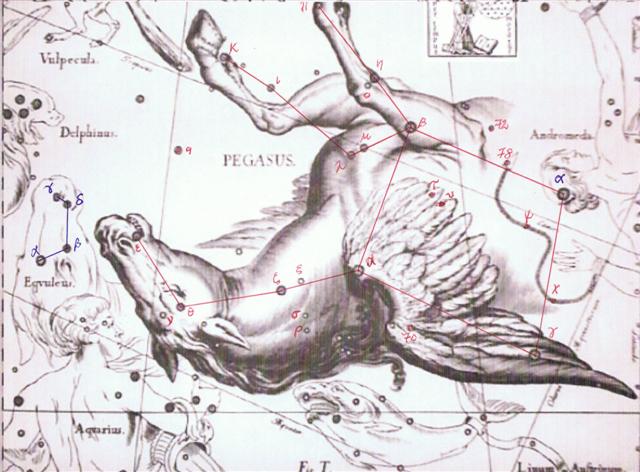349. If the 2nd hipu ('2nd spout') was referring to σ Ceti, then the 1st one ought to correspond to ι Ceti:
|

|
54 = 2 * 27 |

|
|
Gb2-27 → π |
σ Ceti (*36.9) |
|
ι Ceti (*346.0) |
346 + 54 = 400 |
401 - 37 = 364 |

The Southern Fish swallowed all the sweet waters (vai ora) from the jar (hipu) of Aquarius:

By arranging in parallel the stars with the dates from the time when Hyadum II rose with the Sun at 0h (at the beginning of side a) we can see how at that ancient time they seem to have determined their calendar dates from the return to visibility of their heliacal stars. Thus DECEMBER 26 (360) was 16 days later than day 344 corresponding to (at the time of rongorongo) the right ascension postion of ρ Gruis.

... Horapollo, the grammarian of Alexandria, about A.D. 400, tells us that the crane was the symbol of a star-observer in Egypt ...
| CLOSE TO THE SUN: |
| CHRISTMAS EVE |
DEC 25 |
26 (360 = 344 + 16) |
27 |
28 (*282) |
29 |
 |
 |
 |
 |
 |
 |
| Gb2-23 (2 * 23 = 7 * 7) |
*343 = 7 * 7 * 7 |
Gb2-25 (*344.0) |
Gb2-26 (2 * 26) |
Gb2-27 → π (*346) |
Gb2-28 (283) |
| η Aquarii (342.1), σ Gruis (340.4), SITULA (Water-jar) = κ Aquarii (342.7) |
ε Piscis Austrini (343.5), ο Pegasi, β Gruis (343.8) |
ρ Gruis (344.0), MATAR (Rain) = η Pegasi (344.2), η Gruis (344.6), β Oct. (344.7) *280 + *64 = *344 |
λ Pegasi (345.0), ξ Pegasi (345.1), ε Gruis (345.3), τ Aquarii (345.7), ξ Oct. (345.8), μ Pegasi (345.9) |
ι Cephei (346.0), λ Aquarii, γ Piscis Austrini, σ Pegasi (346.5) *346 - *64 = *282 |
SCHEAT AQUARII = δ Aquarii (347.0), ρ Pegasi (347.2), δ Piscis Austrini (347.4), FOMALHAUT (Mouth of the Fish) = α Piscis Austrini, τ Gruis (347.8) |
 |
| DEC 30 (*284) |
31 (365) |
JAN 1 (80 + 286 = 366) |
45 |
 |
 |
 |
| Gb2-29 (284) |
Gb2-30 |
Gb2-31 (286) |
| FUM AL SAMAKAH (Mouth of the Fish) = β Piscium (348.3), ζ Gruis (348.5), ο Andromedae (348.9) |
Al Fargh al Mukdim-24 (Fore Spout) / Purva Bhādrapadā-26 (First of the Blessed Feet) / House-13 (Pig)
SCHEAT PEGASI = β Pegasi, π Piscis Austrini (349.3), κ Gruis (349.4), MARKAB PEGASI = α Pegasi (349.5) |
23h (350.0) υ, θ Gruis (350.0), π Cephei (350.6), ι Gruis (350.9) *350 - *64 = *286 |
 |
| March 4 (*348 = *284 + *64) |
5 (80 + 349 - 365 = 64) |
6 (366 + 64 = 430) |
The beginning of the Pegasus Square was observed in DECEMBER 31 and glyph number 230 was the first on side b of the G tablet.

And from manu rere in day 50 (FEBRUARY 19) to his reversal in Gb8-5 there were 111 days.
| Manu. 1. Bird; manu uru, bird figure (like the drawings or wooden figures once found in caves and houses); manu va'e e-há, four-legged bird (name given to the first sheep introduced to the island. 2. Insect. manupatia, wasp. 3. Bird's egg: mâmari manu. 4. Wild, untamed. 5. Song in which is expressed the desire to kill someone, or in which a crime is confessed: he-tapa i te manu (see tapa). Vanaga. Bird; manu uru, kite; manu rikiriki, insect. P Pau.: manu, bird, insect, brute. Mgv.: manu, bird, beast. Mq., Ta.: manu, bird, insect. Manu nave, great abscess, bubo. Churchill. Manu i te raá = comet. Barthel. Manu vae eha, 'birds with four legs'. Barthel 2. Several of the early missionaries comment with a fine sense of humor upon the mistake the islanders made in calling the cow when first seen a bird. This is the word which led the good missionaries into the error of their own ignorance. Manu is as wholesale in its signification as our word animal, it is generic. In the paucity of brute mammalia the first missionaries found this general term most frequently used of birds, and it was their and not a Polynesian mistake to translate manu into bird. In the material here collected it will be seen that the significations animal and bird are widely extended. In the Paumotu insects are included; the same is true of Mota, where manu signifies beetle as well as bird. Nor is its applicability restricted to earth and air; it reaches into the sea as well. Samoa uses i'amanu (fish-animal) for the whale ... (Churchill 2) |
| Rere. To jump; to run; to fly. Rere-taúra, to carry a child astride on one's shoulder: ku rere-taúra-á i te poki e te matu'a ki te gao, the mother carries her child astride her neck. Vanaga. 1. To fly, to run, to leap, to scale, to be carried away by the wind; ika rere, flying fish; rere aruga, to rebound; hetuu rere, meteor, flying star. Hakarere, to leap. P Pau.: rere, to soar, to fly; fakarere, to precede. Mgv., Ta.: rere, to fly, to leap. 2. To come, to reach to. Mq.: éé mai, to come. 3. To swerve, to deviate. 4. Hakarere, to cease, desist, postpone, quit, vacation; tae hakarere, perseverance. Mq.: rere, to disappear. 5. Hakarere, to save, preserve, put, place, reserve, burden, destine. 6. Hakarere, to abandon, forsake, give up, depose, expose, leave, omit, abjure, repudiate; hakarere ki te hau, uncover the head; hakarere ki te vie, to divorce, hakarere ki raro, to put down, tooa te kiko e ivi i hakarere, to strip off the flesh. Mq.: éé, to run away, to escape. 7. Hakarere? Ikapotu hakarere, to abut, to adjoin; e tahi hakarere, synonym. Churchill. Vi.: Lele, the end of a branch farthest from the body of a tree; leletha, to bend a branch in order to gather the fruit on it. Churchill
2. In the present phase of Polynesian lele so much means to fly that the plainest way of particularizing birds is to describe them as the flying animals, manulele. But to manifest that flight, an exercise or balancing of wings, was by no means the primordial sense, for how could that give rise to a description of water in the water-courses? It will be no end to mass the several significations which lele exhibits ... Flight of birds ... Wind drive ... Meteors ... To leap ... To run ... Flow of water ... To swim ... To sail ... These several activities are exercised in earth, air, and water. The common factor is the swift motion. The means of motion cut no figure. It is an invisible means in the driving of the wind, the flash of the meteor silent athwart the sky on its lethal errand, the slip and slide of the stream in its deep course, the set of the sea, the gliding of the canoe upon its surface. Churchill 2. |
| FEBR 19 (50) |
110 |
JUNE 10 (161) |
 |
 |
| Gb4-15 (335) |
Gb8-5 (446) |
| *34 |
UKDAH (*145) |
.jpg)
... The month, which takes its name from Juppiter the oak-god, begins on June 10th and ends of July 7th. Midway comes St. John's Day, June 24th, the day on which the oak-king was sacrificially burned alive. The Celtic year was divided into two halves with the second half beginning in July, apparently after a seven-day wake, or funeral feast, in the oak-king's honour ...
|











.jpg)